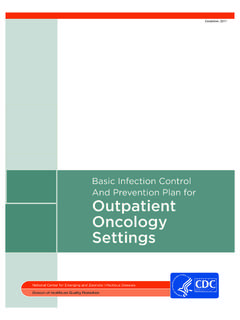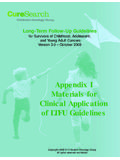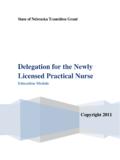Transcription of Infusion Reactions
1 E10 April 2010 Volume 14, Number 2 Clinical Journal of oncology NursingAt a GlanceMonoclonal antibodies have a unique potential for a non- allergic Infusion reaction caused by cytokine and expert management of a cytokine-release re- action may enable patients to be rechallenged with the mono-clonal antibody, potentially improving clinical safety of rapid infusions of rituximab is under investiga- tion, and initial findings of several trials reported that after successful first-cycle dosing according to manufacturer s protocol, subsequent doses may be delivered by rapid Infusion .
2 Cancer therapies administered by IV Infusion may cause Infusion Reactions . Infusion Reactions always involve the immune system; however, some (of-ten called anaphylactic) are allergic in nature and typically are mediated by immunoglobulin E (IgE), whereas others (anaphylactoid) are not true allergic Reactions and are not mediated by IgE (Kemp, Lockey, & Simons, 2008). Regardless of whether the reaction is allergic or nonallergic, clinical manifestations are the same and require prompt, ac-curate assessment and astute management to prevent severe adverse events, which can include death.
3 Understanding the pathophysiology underlying each Infusion reaction will en-hance decision making regarding rechallenge, thus potentially improving treatment antibodies are a valuable treatment component for many different types of cancers as well as nonmalignant disorders. Monoclonal antibodies also have a unique side-effect profile and generally are better tolerated than chemotherapy in the author s experience. A distinctive side effect of monoclonal antibodies is the potential for nonallergic Infusion Reactions caused by cytokine release.
4 Less frequently, monoclonal anti-bodies can cause allergic Infusion Reactions . Although severe Infusion Reactions are rare, nurses must be familiar with these adverse events and know how to identify patients at particular risk and take preventive article presents an overview of the pathophysiology of Infusion Reactions precipitated by monoclonal antibodies, par-ticularly rituximab. Rituximab serves as an example of a drug Wendy H. Vogel, MSN, FNP, AOCNP , is an oncology nurse practitioner at Kingsport Hematology- oncology Associates in Tennessee.
5 Mention of specific products and opinions related to those products do not indicate or imply endorsement by the Clinical Journal of oncology nursing or the oncology nursing Society. (First submission June 2009. Revision submit-ted August 2009. Accepted for publication August 2, 2009.)Digital Object Identifier: material is protected by copyright law. To purchase quantity reprints, e-mail For permission to reproduce multiple copies, e-mail the potential for varying types of Infusion Reactions . Much clinical experience can be draw from rituximab because it was one of the first monoclonal antibodies.
6 In addition, oncology nurses role in patient risk assessment, institution of prophylactic Wendy H. Vogel, MSN, FNP, AOCNP Many cancer therapies administered by IV Infusion , including monoclonal antibodies, have the potential for Infusion reac-tions. All Infusion Reactions involve the immune system; however, some (anaphylactic) are allergic in nature and usually are mediated by immunoglobulin E (IgE), whereas others (anaphylactoid) are not true allergic Reactions and are not mediated by IgE. Although Reactions can be allergic or nonallergic, the clinical manifestations are the same and require prompt, accurate assessment and astute management to avoid severe adverse events, including fatality.
7 Monoclonal antibodies have a unique side-effect profile that includes the potential for nonallergic Infusion Reactions caused by cytokine release. Understanding the pathophysiology underlying any Infusion reaction will enhance decision making regarding rechallenge and thereby improve treatment outcomes. Rituximab is an example of a drug with the potential for varying types of infu-sion Reactions . This article discusses oncology nurses role in patient risk assessment, institution of prophylactic measures, administration monitoring, severity grading, management, and follow-up.
8 This understanding will clarify new data regarding the safety of a rapid Infusion schedule of rituximab. Infusion Reactions : Diagnosis, Assessment, and ManagementOnline Exclusive Journal ClubClinical Journal of oncology nursing Volume 14, Number 2 Infusion Reactions : Diagnosis, Assessment, and Management E11measures, administration monitoring, severity grading, man-agement, and follow-up will be defined. New data regarding the safety of a rapid Infusion schedule of rituximab also will be of the Immune SystemReviewing the body s immune response to a foreign substance is helpful to comprehend the origin of an Infusion reaction.
9 Essentially, the administration of any foreign drug is likely to elicit some response from the immune system; most often, the response is a minor, subclinical, and transient reaction. Serious symptoms or issues arise when the immune system overreacts ( , hypersensitivity), particularly if the immune response is very sudden and severe. The immune response can be innate, adaptive, or both. An in-nate response is a nonspecific, rapid response and is the body s first line of defense. Innate immunity is present even prior to any exposure to the foreign substance and is not affected by expo-sure (Solomon & Komanduri, 2001).
10 In contrast, the adaptive re-sponse is an acquired response that is more specific and involves memory. With adaptive immunity, each successive exposure to the foreign substance increases the defensive response of the immune system. Table 1 shows the different cells and chemical messengers involved in both systems, noting immune responses are directed by lymphocytes and are either humoral or cell-mediated. Two types of lympho-cyte exist: B lymphocytes and T lymphocytes. B lymphocytes respond to extracellular foreign substances, whereas T lymphocytes respond to intracellular foreign substances (Solo-mon & Komanduri, 2001).







